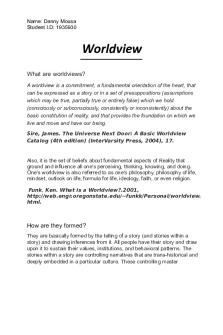What are two parts to recursion PDF

| Title | What are two parts to recursion |
|---|---|
| Author | winson chisom |
| Course | Programming 2 |
| Institution | University of the People |
| Pages | 8 |
| File Size | 174.7 KB |
| File Type | |
| Total Downloads | 60 |
| Total Views | 159 |
Summary
self quiz...
Description
What are two parts to recursion? Select one: a. (1) If the problem is easy, solve it immediately, and (2) If the problem can't be solved immediately, divide it into smaller problems.
b. (1) Divide the problem into smaller problems, and (2) give immediate solutions for the hard problems. c. (1) Discard the hard cases , and (2) solve the easy easy cases. d. (1) Solve the problem by asking it to solve itself, (2) Solve the easy cases in one step. Feedback The correct answer is: (1) If the problem is easy, solve it immediately, and (2) If the problem can't be solved immediately, divide it into smaller problems.
Question 2 Correct Mark 1.00 out of 1.00
Flag question Question text
How can you drink an entire keg of root beer? Select one: a. (1) take one swallow, then (2) take another swallow. b. (1) If the keg is empty do nothing, otherwise (2) take one swallow, then drink the rest of the keg.
c. (1) take one enormous gulp, and (2) wish you hadn't. d. (1) drink one keg, and (2) drink another keg. Feedback The correct answer is: (1) If the keg is empty do nothing, otherwise (2) take one swallow, then drink the rest of the keg.
Question 3 Correct Mark 1.00 out of 1.00
Flag question Question text
How do you study a text book? Select one: a. (1) Read the book on day 1, and (2) read it again each day of the semester. b. (1) If you have reached the end of the book you are done, else (2) study one page, then study the rest of the book.
c. (1) Divide the book in two, and (2) study each half. d. (1) Cram all the pages in one horrible session, and (2) forget everything the next night. Feedback The correct answer is: (1) If you have reached the end of the book you are done, else (2) study one page, then study the rest of the book.
Question 4 Correct Mark 1.00 out of 1.00
Flag question Question text
Which answer is a correct skeleton for a recursive Java method? A. int solution( int N ) { if ( base case ) { return something easily computed } else { divide problem into pieces return something calculated from the solution to each piece } }
B. int solution( int N ) { if ( base case ) { return something easily computed } else { return solution(N) } } C. int solution( int N ) { divide problem into pieces return something calculated from the solution to each piece } D. int solution( int N ) { divide problem into pieces if ( base case ) { return something easily computed } else { return something calculated from the solution to each piece } } Select one: a.
b. c. d. Feedback The correct answer is: a.
Question 5 Correct Mark 1.00 out of 1.00
Flag question Question text
Which of the following statements are true? Select one: a. The Fibonacci series begins with 0 and 1, and each subsequent number is the sum of the preceding two numbers in the series.
b. The Fibonacci series begins with 1 and 1, and each subsequent number is the sum of the preceding two numbers in the series. c. The Fibonacci series begins with 1 and 2, and each subsequent number is the sum of the preceding two numbers in the series. d. The Fibonacci series begins with 2 and 3, and each subsequent number is the sum of the preceding two numbers in the series. Feedback The correct answer is: The Fibonacci series begins with 0 and 1, and each subsequent number is the sum of the preceding two numbers in the series.
Question 6 Correct Mark 1.00 out of 1.00
Flag question Question text
In the following method, what is the base case? static int xMethod(int n) { if (n == 1) return 1; else return n + xMethod(n - 1); } Select one: a. n is 1
b. n is greater than 1.
c. n is less than 1. d. no base case. Feedback The correct answer is: n is 1
Question 7 Not answered Marked out of 1.00
Flag question Question text
Consider the following two programs: A. public class Test { public static void main(String[] args) { xMethod(5); } public static void xMethod(int length) { if (length > 1) { System.out.print((length - 1) + " "); xMethod(length - 1); } } } B. public class Test { public static void main(String[] args) { xMethod(5); } public static void xMethod(int length) { while (length > 1) { System.out.print((length - 1) + " "); xMethod(length - 1); } } } Select one: a. The two programs produce the same output 5 4 3 2 1. b. The two programs produce the same output 1 2 3 4 5. c. The two programs produce the same output 4 3 2 1. d. The two programs produce the same output 1 2 3 4.
e. Program A produces the output 4 3 2 1 and Program B prints 4 3 2 1 1 1 .... 1 infinitely Feedback The correct answer is: Program A produces the output 4 3 2 1 and Program B prints 4 3 2 1 1 1 .... 1 infinitely
Question 8 Correct Mark 1.00 out of 1.00
Flag question Question text
What code is missing to complete the following method for sorting a list? public static void sort(double[] list) { ___________________________; } public static void sort(double[] list, int high) { if (high > 1) { // Find the largest number and its index int indexOfMax = 0; double max = list[0]; for (int i = 1; i max) { max = list[i]; indexOfMax = i; } } // Swap the largest with the last number in the list list[indexOfMax] = list[high]; list[high] = max; // Sort the remaining list sort(list, high - 1); } } Select one: a. sort(list) b. sort(list, list.length) c. sort(list, list.length - 1)
d. sort(list, list.length - 2)
Feedback The correct answer is: sort(list, list.length - 1)
Question 9 Correct Mark 1.00 out of 1.00
Flag question Question text
For a linked list to be used in a program, that program needs: i. A variable that refers to the first node in the list. ii. A pointer to the first node. iii. A null pointer in the last node. Select one: a. i and ii b. i c. ii and iii d. i, ii and iii
Feedback The correct answer is: i, ii and iii
Question 10 Correct Mark 1.00 out of 1.00
Flag question Question text
Suppose cursor refers to a node in a linked list (using the IntNode class with instance variables called data and link). What statement changes cursor so that it refers to the next node? Select one: a. cursor++; b. cursor = link; c. cursor += link;
d. cursor = cursor.link;
Feedback The correct answer is: cursor = cursor.link;...
Similar Free PDFs

What are two parts to recursion
- 8 Pages

Recursion
- 11 Pages

What Are Other payables
- 1 Pages

What are transition metals
- 14 Pages

What are worldviews
- 3 Pages

What are conf inter
- 8 Pages

Recursion
- 18 Pages

Week Two, What is Dramaturgy
- 5 Pages

Material What are you doing
- 38 Pages

What are physics Whistles Essay
- 3 Pages

you are what you buy
- 2 Pages

Kanji-parts - Kanji-parts
- 2 Pages
Popular Institutions
- Tinajero National High School - Annex
- Politeknik Caltex Riau
- Yokohama City University
- SGT University
- University of Al-Qadisiyah
- Divine Word College of Vigan
- Techniek College Rotterdam
- Universidade de Santiago
- Universiti Teknologi MARA Cawangan Johor Kampus Pasir Gudang
- Poltekkes Kemenkes Yogyakarta
- Baguio City National High School
- Colegio san marcos
- preparatoria uno
- Centro de Bachillerato Tecnológico Industrial y de Servicios No. 107
- Dalian Maritime University
- Quang Trung Secondary School
- Colegio Tecnológico en Informática
- Corporación Regional de Educación Superior
- Grupo CEDVA
- Dar Al Uloom University
- Centro de Estudios Preuniversitarios de la Universidad Nacional de Ingeniería
- 上智大学
- Aakash International School, Nuna Majara
- San Felipe Neri Catholic School
- Kang Chiao International School - New Taipei City
- Misamis Occidental National High School
- Institución Educativa Escuela Normal Juan Ladrilleros
- Kolehiyo ng Pantukan
- Batanes State College
- Instituto Continental
- Sekolah Menengah Kejuruan Kesehatan Kaltara (Tarakan)
- Colegio de La Inmaculada Concepcion - Cebu



